Successful freight brokerages recognize that digital transformation continues to upend the industry. However, that is not all bad. Remember that shipping analytics is essential to identifying and overcoming disruption. And disruption continues to evolve and present new challenges, including a misplaced perception that digital technology will threaten such companies’ success.
Supply and Demand Chain Executive reports, “In this state of flux, some have questioned the future of traditional professions in transportation, such as freight brokers and even truck drivers. Yet, the issue is a matter of perception: while novelties brought about by digitalization can be seen as a threat, they also present powerful opportunities for those who are open to them.” It is essential to understand the five ways that FreightWaves SONAR enables competition through shipping analytics that add value for brokers.
Measuring brokerages’ performance means prioritizing loads based on the most profitable and easy to cover moves. By identifying trends within the market, such as origin-destination pairings, brokers can better prioritize load quoting and execution. Prioritizing loads is not as simple as booking those with lead times between two and five days.
Instead, it can mean the difference between paying extra fees for expedited shipping and handling within hours, if not minutes, of initially receiving a request for a quote. Capacity is finite. And freight brokerages must prioritize loads on the fly with the right broker resources. They must know when waiting until after the next break would otherwise result in a significant loss. That amounts to savings amplified out and across your transportation network.

Brokers’ entire businesses are transportation. And while exceptions occur for brokers that may offer some in-house fleets, it will always be necessary to onboard new carriers and lanes. There is another advantage to using SONAR data during onboarding processes. SONAR data allows users to measure the performance of their existing contracts and client interactions. And since SONAR data applies near-real-time insights, it naturally leads to data-driven carrier scorecard management of carrier relationships. And leveraging shipping analytics in SONAR to inform those negotiations and conversations is essential.
Informed conversations do not necessarily end with broker-carrier interactions. There’s a perception by some that shippers are always at the mercy of brokers, but that’s rarely true. Shippers that view brokerages as price-gouging entities that attempt to generate additional revenue without justification are simply wrong. The reality is that even brokers are subject to the pricing structures of carriers. The cycle continues to costs and results in higher freight rates. However, using SONAR shipping analytics helps inform conversations and explain why further price increases or variances within surcharges occur. Therefore, brokers have the opportunity to build a better rapport with shipper-clients and can point to the actual causes of increased rates. Shippers are then more likely to engage the same broker in the future during freight negotiations.
Increased confidence among clients will naturally benefit the brokerage from increased word-of-mouth advertising and increased throughput. Given the significant advancement of e-commerce in recent years, keeping shipper clients happy is a critical step to maintaining long-term growth and success as a brokerage.
Applied transportation data further empower frontline brokerage workers with the insights necessary to speed quoting processes. Instead of looking across multiple systems that rely on week-old shipping analytics, frontline workers can access SONAR data, review market trends, identify the trends unique to each move, and quickly determine a best-case and worst-case scenario for rating. In turn, that translates to faster-quoting processes, more accurate quotes indicative of market conditions, and the ability to preempt market changes when clients have an extended lead time.
Data is everything in the modern supply chain. Unfortunately, insufficient and/or old data insights will do more harm than good. Making decisions based on outdated data can lead to an effective doubling of shipping rates, and when a brokerage promises a rate to a client, they assume the risk for market conditions. Therefore, it is in the broker’s best interest to identify market trends in advance and use predictive rates when quoting and executing any load. SONAR makes that possible. Request your SONAR demo by clicking the button below now!
